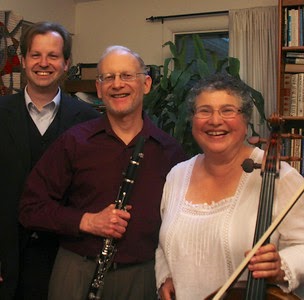Ronen Chamber Ensemble celebrates Black History Month at UIndy
 |
| Gregory Martin (from left), David Bellman, and Ingrid Fischer-Bellman. |
The Voices of Worship Choir from the university was on hand to wrap things up in spirited fashion with two gospel numbers under the direction of Geoffrey Kelsaw. No mention was made of the reason for Bellman's absence; his mother died a few days ago, and the Indianapolis Symphony Orchestra principal clarinetist was in Albuquerque.
Consequently, Ronen's part of the program required the elimination of a movement from David Baker's Duo for Clarinet and Cello, a Ronen commission. Also, Christina Martin substituted in the clarinet chair for a performance of Anthony Kelley's "Grist for the Mill" (for flute, clarinet, cello, and percussion).
"Grist for the Mill" is a witty, unpretentious two-movement work, with an array of percussion accessorizing the jazz-inflected combo of flute, clarinet and cello. Jimmy Finnie of Indiana State University supplied the percussive decoration (including the lion's roar, a delight for all ages — in small doses) for the smoothly working ensemble of clarinetist Martin, cellist Ingrid Fischer-Bellman, and flutist Tamara Thweatt.
That plus the Voices of Worship selections constituted the second half; the first was dominated by Gregory Martin, UIndy faculty pianist and composer. Last year he became Ronen co-artistic director with the founding Bellmans.
Martin played three solo pieces by 20th-century black women. Julia Perry's "Prelude for Piano," Betty Jackson King's "Spring Intermezzo," and Margaret Bonds "Troubled Water" made a sonata-like whole, with the pastel lyricism of the King piece bookended by the moody yet inviting Perry and the bravura reworking of "Wade in the Water" by Bonds to conclude.
The concert opened with a four movement work in the same vein — respectful interpretations of the rich "Negro spiritual" heritage by Undine Smith Moore under the title Afro-American Suite for Flute Cello, and Piano. Thweatt, Fischer-Bellman, and Martin gave a winning account of the piece, which included the haunting voice of the alto flute to distinguish the slow movement, based on "Who's That Comin'." Also admirable was Fischer-Bellman nicely turned statement of the melody, with its imitation of characteristically black vocal ornamentation.
After Thweatt tastefully read Ntozake Shange's "I Live in Music," Fischer-Bellman and Gregory Martin closed the first half with the slow movement of Baker's Sonata for Cello and Piano. It features substantial unaccompanied recitative-like episodes for the cello, which Fischer-Bellman wonderfully projected into the sympathetic environment of Lilly Performance Hall — offering a great reminder of the Indianapolis-born cellist-composer's abundant contributions to both jazz and contemporary classical music.



Comments
Post a Comment